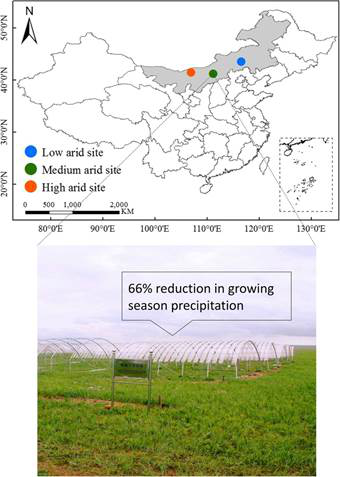研究揭示干旱對(duì)植物群落的調(diào)控機(jī)制

近日���,中科院沈陽生態(tài)所生態(tài)計(jì)量化學(xué)團(tuán)隊(duì)以植物群落養(yǎng)分計(jì)量為核心,基于草地樣帶調(diào)查和控制實(shí)驗(yàn)的多源數(shù)據(jù)開展定量評(píng)估,闡釋了植物對(duì)長期和短期水分脅迫的響應(yīng)機(jī)制。相關(guān)成果發(fā)表于《生態(tài)學(xué)》(Ecology)����。
在全球氣候變化背景下�,內(nèi)蒙古草原干旱強(qiáng)度和頻度呈多發(fā)趨勢(shì)。水分是該生態(tài)系統(tǒng)植物生存和繁衍的主要驅(qū)動(dòng)因子����,干旱事件將對(duì)草原生態(tài)系統(tǒng)結(jié)構(gòu)和功能產(chǎn)生深遠(yuǎn)影響。
氮和磷是影響陸地生態(tài)系統(tǒng)植物生存�����、生長和繁殖的主要因子���。因此��,該團(tuán)隊(duì)以群落養(yǎng)分計(jì)量為全新理念和視角���,探究水分脅迫對(duì)生態(tài)系統(tǒng)結(jié)構(gòu)和功能影響的內(nèi)在機(jī)制和過程,厘清種內(nèi)和種間的競爭作用關(guān)系對(duì)群落結(jié)構(gòu)和動(dòng)態(tài)的影響�����,旨在為理解草地退化機(jī)制���、加快退化草地恢復(fù)提供參考��。
研究結(jié)果顯示���,長期水分脅迫下,植物通過內(nèi)穩(wěn)態(tài)機(jī)制提高養(yǎng)分濃度����,增強(qiáng)群落的抵抗能力,物種周轉(zhuǎn)是該過程的主要影響因素�����,但在短期干旱條件下,群落養(yǎng)分對(duì)水分脅迫的響應(yīng)更復(fù)雜�����。整體而言��,群落氮濃度上升�、磷濃度下降時(shí),種內(nèi)競爭和物種周轉(zhuǎn)共同影響該生態(tài)過程����。此外,不同區(qū)域群落養(yǎng)分響應(yīng)程度具有明顯差異�����。極度干旱地區(qū)�����,植物群落養(yǎng)分抵御水分脅迫的能力最強(qiáng)�,響應(yīng)最遲緩。
該團(tuán)隊(duì)表示����,未來研究應(yīng)建立大型聯(lián)網(wǎng)干旱實(shí)驗(yàn)平臺(tái)�,緊密結(jié)合控制實(shí)驗(yàn)和自然梯度實(shí)驗(yàn)����,提高實(shí)驗(yàn)結(jié)果的準(zhǔn)確性和有效性���,為建立草地生態(tài)系統(tǒng)自然評(píng)估體系提供重要理論依據(jù)�。(來源:中國科學(xué)報(bào)唐鳳)
?
Differential responses of canopy nutrients to experimental drought along a natural aridity gradient
?
Abstract??The allocation and stoichiometry of plant nutrients in leaves reflect fundamental ecosystem processes, biotic interactions, and environmental drivers such as water availability. Climate change will lead to increases in drought severity and frequency, but how canopy nutrients will respond to drought, and how these responses may vary with community composition along aridity gradients is poorly understood. We experimentally addressed this issue by reducing precipitation amounts by 66% during two consecutive growing seasons at three sites located along a natural aridity gradient. This allowed us to assess drought effects on canopy nitrogen (N) and phosphorus (P) concentrations in arid and semiarid grasslands of northern China. Along the aridity gradient, canopy nutrient concentrations were positively related to aridity, with this pattern was driven primarily by species turnover (i.e., an increase in the relative biomass of N‐?and P‐rich species with increasing aridity). In contrast, drought imposed experimentally increased N but decreased P concentrations in plant canopies. These changes were driven by the combined effects of species turnover and intraspecific variation in leaf nutrient concentrations. In addition, the sensitivity of canopy N and P concentrations to drought varied across the three sites. Canopy nutrient concentrations were less affected by drought at drier than wetter sites, because of the opposing effects of species turnover and intraspecific variation, as well as greater drought tolerance for nutrient‐rich species. These contrasting effects of long‐term aridity vs. short‐term drought on canopy nutrient concentrations, as well as differing sensitivities among sites in the same grassland biome, highlight the challenge of predicting ecosystem responses to future climate change.